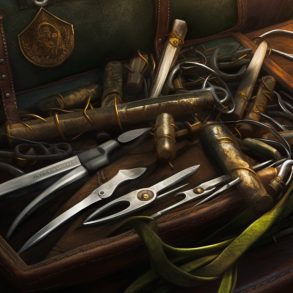Getting hit hurts and can lead to a problematic condition known as ‘needing a new character,’ and avoiding that is where armor comes in handy. In this article, we’ll take a look at how armor works in 5E and interesting ways to use them.
How armor works
Armor works by replacing the base AC calculation, how it changes depends on the type of armor worn. You must have proficiency in the type of armor you are wearing to be able to wear it effectively, if you don’t have proficiency then you will be unable to cast spells and have disadvantage on all ability checks, attack rolls, and saving throws that use either Strength or Dexterity. Some armors give you disadvantage on Stealth rolls and some require a minimum Strength score to avoid reducing your speed by 10 ft.
Additional rules related to armor are found in Xanathar’s Guide to Everything (XGtE) and cover resting in armor under the Sleep section. Under these optional rules, taking a long rest where you sleep in medium or heavy armor results in not reducing any existing levels of exhaustion and only recovering a quarter of your spent Hit Dice. Resting in light armor has no disadvantages.
The armor available in 5E is broken into three categories, here we will list the armors organized by these categories, if an armor has a Strength requirement it will be noted. Any armors noted with * give disadvantage on Stealth checks:
Light Armor
Light armors allow you to add your entire Dexterity modifier to the base AC that they offer. This armor takes 1 minute to don or doff.
Padded* – This quilted armor costs 5 GP and gives a base AC of 11.
Leather – Made from boiled leather, this armor costs 10 GP and gives a base AC of 11.
Studded Leather – Leather reinforced with studs, rivets, or spikes makes up this armor, which costs 45 GP and gives a base AC of 12.
Medium Armor
Medium armors offer a higher base AC than light armors, but only allow you to add a maximum of +2 from your Dexterity modifier. This armor takes 5 minutes to don and 1 minute to doff.
Hide – A basic armor of thick pelts and furs, this costs 10 GP and provides a base AC of 12.
Chain Shirt – A shirt of metal rings worn between layers of other materials, this costs 50 GP and provides a base AC of 13.
Scale Mail* – This armor consists of leather covered with small metal plates which overlap, this costs 50 GP and provides a base AC of 14.
Breastplate – A well-fitted metal chest plate supplemented with leather, this costs 400 GP and provides a base AC of 14.
Half Plate* – This armor mostly leaves the legs unprotected but covers the upper body with shaped plates. This costs 750 GP and provides a base AC of 15.
Heavy Armor
Heavy armor gives you a set AC, rather than incorporating your Dexterity modifier. This armor takes 10 minutes to don and 5 minutes to doff.
Ring Mail* – Leather reinforced with large metal rings, this armor is worn by those that can’t afford chain mail. This armor costs 30 GP and provides a set AC of 14.
Chain Mail* [Str 13] – A full suit of metal rings worn over quilted fabric, this costs 75 GP and provides a set AC of 16.
Splint* [Str 15] – This armor uses a base layer of quilted fabric, with leather on top which has narrow metal strips riveted to it. This armor costs 200 GP and provides a set AC of 17.
Plate* [Str 15] – This iconic knight’s armor is made up of shaped metal plates which interlock to protect the whole body. This armor costs 1,500 GP and provides a set AC of 18.
Your protective cocoon
If you’re enamored with the idea of getting more out of your armor or protecting your squishy parts even better, then fear not! Here are some examples to get your creative juices flowing:
Armorer – These Iron Man-inspired Artificers gain a bevy of armor-related benefits, from donning and doffing heavy armor in a single action and ignoring Strength requirements to being able to add more infusions to their armor than other Artificers. These infusions can greatly enhance the features of the armor by just increasing the AC or adding more impressive features like teleportation.
Battlerager – This oft-forgotten about Barbarian subclass was published in the SCAG and gets access to a unique set of medium armor, spiked armor. This allows them to make a bonus action attack and deal additional damage when grappling a creature.
Forge Domain – This Cleric subclass can use their Blessing of the Forge feature to enchant a suit of armor to be +1.
Medium Armor Master – Also known as MAM, this feat allows you to use up to +3 from your Dexterity modifier with medium armor and removes the disadvantage on Stealth from any medium armor that has that trait. A character wearing half plate with this feat would have the same AC as someone wearing plate but have better Stealth rolls.
Heavy Armor Master – Affectionately known as HAM, this half feat increases your Strength by 1 and reduces any nonmagical bludgeoning, piercing, or slashing damage you take whilst wearing heavy armor by 3. This feat can make a PC incredibly tanky in early levels and stays relevant thanks to the lack of magical BPS attacks on most monsters, even at higher challenge ratings.
Warforged – These constructs with a soul are fantastic armor-users thanks to their Inegrated Protection feature, which allows them to integrate the armor into their very body. This takes an hour but once done prevents that armor from being removed from the warforged against their will. The same feature also gives them a +1 to their AC whether or not they’re wearing armor, great for pushing your AC numbers even higher!
We hope that this article has been helpful and helped protect those squishy vital organs of yours from those ravenous monsters. If you’re a new player learning the game, then check out our how to play DnD 5E section, or if you’re here because you’re considering what armor to use on your Fighter, then check out our Fighter 5E guide. Until next time, may your joints not clank during times of stealth, and may your helmet protect you from unexpected sling bullets.
What is armor in DnD 5E?
Armor in DnD 5e refers to protective clothing and equipment that characters wear to reduce the damage they take from attacks.
What types of armor are available in DnD 5E?
There are several types of armor available in DnD 5E, including light armor, medium armor, and heavy armor. Light armor provides the least protection but allows you to incorporate your entire Dexterity modifier, medium armor provides a higher AC but restricts you to a maximum of +2 from your Dexterity, and heavy armor just provides a set AC with no use of your Dex mod. Some medium armors and all heavy armors give the wearer disadvantage on Stealth checks.
How does armor affect a character’s ability to move and perform actions in DnD 5E?
Some forms of armor impose disadvantage on the wearer’s Stealth checks and most heavy armors require a minimum Strength score, reducing the users speed by 10 feet if they are not strong enough to wear it.






